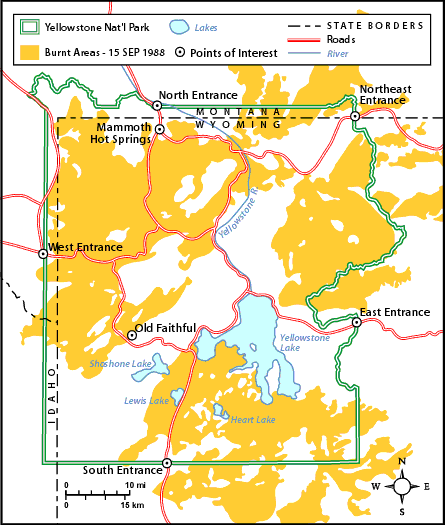
Situation
In Yellowstone National
Park, the fire season usually lasts from June to early September. In 1988,
several factors led to an abnormal fire season. During June of that year,
there was little rain and extremely high temperatures and winds. Yellowstone
National Park was suffering from severe drought conditions. The drought
left Yellowstone more vulnerable to fires than usual. Several fires were
started by lightning and several by human activities. By July 21, many
thousands of acres had burned. The Yellowstone National Park fires of
1988 were the largest series of fires in the northern Rockies during the
last 50 years. The fires of 1988 led to an intense public debate regarding
the National Park Service's fuel management
policy. This policy stated that fires started by natural causes should
be allowed to burn to their natural conclusion.
In 1995, a report by the Congressional Research Service stated that the current fuel management policy's reduction of fire control costs and damages is not well documented. For this reason, a group of concerned government agencies has contacted your team of environmental biologists. This group would like your help in resolving this policy debate. They would like to know whether or not to allow naturally-caused fires in national parks to burn to their natural conclusion. The government agencies are particularly interested in your recommendations based on your Earth System Science (ESS) analysis of a fire's impact on the air, land, water, and living things.

Help the Forest Service make a decision. The next time there's a natural fire in Yellowstone National Park, should they try to put it out or let it burn? Perform an ESS analysis to predict the results under the existing policy and to support any recommendations you would make to revise the policy.
Using the protocol below and other available resources, prepare a report or presentation based on your ESS analysis in which you and your team make recommendations, predictions, inferences, or other appropriate resolutions about the problem. Be prepared to support the position you take.
Protocol
First, you will perform
an Earth system science analysis. Then, you will make predictions, based
on the results of the ESS analysis, concerning the policy debate about
whether to let naturally-caused fires in national parks burn to their
natural conclusion.
Follow the steps below. They will help you make recommendations, predictions, inferences, or other appropriate resolutions to the task force of concerned government agencies.
Step 1 -- List what is known.
Step 2 -- List what is needed.
Step 3 -- Gather information to complete an ESS analysis.Part I Event
Sphere
Part II SphereSphere
Step 4 -- Present your findings.
HTML code by Chris
Kreger
Maintained by ETE
Team
Last updated April 28, 2005
Some images © 2004 www.clipart.com
Privacy Statement and Copyright © 1997-2004 by Wheeling Jesuit University/NASA-supported Classroom of the Future. All rights reserved.
Center for Educational Technologies, Circuit Board/Apple graphic logo, and COTF Classroom of the Future logo are registered trademarks of Wheeling Jesuit University.
